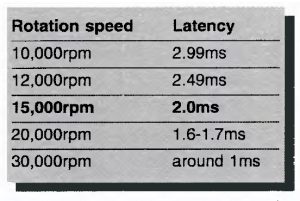History 2000: Seagate Cheetah X15 World’s Fastest HDD
At 15,000rpm
By Jean Jacques Maleval | September 14, 2022 at 2:01 pmThe new Cheetah X15 from Seagate Technology, the first to offer platters that spin at a record rotational speed of 15,000rpm, is by far the fasted HDD in the world today.

Until now, several manufacturers offered devices at 10,000rpm, a speed only Hitachi succeeded in beating, with 12,000rpm on its Pegasus 2.
With Seagate’s greater rotational speed, latency is as low as 2.0ms. If we add the gain in average seek time, which gets down to 3.9ms using 2.5-inch diameter platters, we get an average data access time of 6.4ms (in read mode), including 0.5ms for the commands. You can’t do better than this right now.
And in the future? Rudy Thibodeau, Seagate’s executive director of enterprise product marketing, thinks that the next natural step should be 20,000rpm, but cautions that this will not necessarily lead to enormous gains, since seek time will only be reduced from 2.0ms to roughly 1.6-1.7ms. To get down to a single millisecond, which would not be an enormous leap in terms of access, the platters would need to spin at 30,000rpm!
Seagate’s choice to move from 3.0-inch platters, as with its Cheetah 346LP, to 2.5-inch disks in the new machine has both good and bad aspects.
Capacity suffers, at 3.7GB per (non-glass) disk, for a total of 18.4GB, using 5 disks and 10 GMR heads. The formatted data rate, although already between 37 and 47.4 MB/s, would have been greater on larger disks.
However, according to the manufacturer, “Once the drive is on track and ready to provide data, these features allow for the transfer of data at a rate which is 25% faster than current generation 10,000rpm drives.”
Conversely, the average seek time is lower, and more than anything, power consumption is also down.
Seagate had a few problems with its first high-speed units, which became furnaces when operating. Now, the Cheetah X15 at 15,000rpm consumes between 11-12.5W in idle mode, exactly the same power usage as on the Cheetah 36LP at 10,000rpm.
“The same power consumption and cooling requirements as 3rd generation Cheetah 18LM will allow OEMs and integrators to easily integrate the drive in existing platforms,” pointed out Thibodeau.
He further explained that his company is now orienting itself towards 2 lines of enterprise HDDs (just like Hitachi): high-speed models such as the X15, with diminished capacity, on the one hand, and fat disks where capacity is more important than speed, on the other. Users may then choose according to whether their applications require lots of capacity or a greater number of IO/s (33% more than the Cheetah 18XL and 66% better than the Barracuda 18XL for the X15, according to Seagate’s own testing).
The Cheetah X15 should be in production by the 3Q20, in UltraSCSI or 2Gb FC, with 4MB of cache (expandable to 16MB), for a price that was unavailable at press time, but should fall below $1,000.
With the first 15,000rpm drive, Seagate, which was already the first to launch a 7,200rpm and then a 10,000rpm drive, is once again at the head of the pack, although it won’t be long before Hitachi, and above all IBM, Seagate’s fiercest competitor in the server drive niche, react.

This article is an abstract of news published on issue 145 on February 2000 from the former paper version of Computer Data Storage Newsletter.
Note: No more 15,000rpm HDDs are actually offered and faster speed never were announced because of heat.













 Subscribe to our free daily newsletter
Subscribe to our free daily newsletter

